One of the four principal goals of the welfare reform of 1996 was to increase married two-parent families. The current welfare reform proposals advanced by President George W. Bush and recently enacted by the House of Representatives (H.R. 4737) include specific policies aimed at encouraging healthy marriages. Supporters of this approach contend that an increase in healthy marriages will improve child well-being and reduce child poverty. Opponents argue that there is little or no link between increasing marriage and reducing poverty. They argue that the government should ignore the issue of marriage and should focus instead on increasing maternal education as the primary means of combating child poverty.
Given this policy context, this Heritage Foundation Center for Data Analysis Report examines two questions: Is marriage effective in reducing child poverty? What is the comparative effect of marriage and maternal education in combating child poverty? Using data from the National Longitudinal Survey of Youth (NLSY), the CDA analysis produced the following findings:
- Marriage plays a powerful role in lifting children out of poverty.
- While both marriage and maternal education play a positive role in alleviating child poverty, in general, stable marriage has a far stronger effect than does maternal schooling.
Maternal education without marriage is generally ineffective in reducing child poverty. The poverty levels of children raised by never-married mothers remain high even if the mother has a high-school or college degree.
Specifically, the analysis reveals the following facts:
- On average, a child raised by a never-married mother is nine times more likely to live in poverty than a child born and raised by two parents in an intact marriage.
- Overall, nearly 80 percent of long-term child poverty occurs to children raised in some type of broken family or by a parent who never married.
- Raising a child in an intact marriage is roughly two and a half times more effective than adding four years to a mother's education in reducing child poverty.
- On average, a child raised by a never-married mother with a four-year college degree is three and a half times more likely to be poor than is a child born and raised in an intact married family by a mother who has only a high-school education.
- Children raised in intact married families whose mothers are high-school dropouts spend about the same amount of time in poverty as children raised by never-married mothers who have a four-year college degree.
- Marriage has a significant effect in reducing child poverty, even if the marriage does not last throughout a boy's or girl's entire childhood. Being raised in a married two-parent family for just half of one's childhood reduces poverty as much as adding four years to a mother's education does.
This CDA Report will first illustrate the major arguments of the "education versus marriage" debate and will then present an analysis of child poverty using NLSY data. From these data, some inferences can be made regarding the relative effectiveness of marriage and educational attainment in alleviating child poverty.
Policy Background
Two of the four main goals of the welfare reform of 1996 were to increase the number of married two-parent families and reduce out-of-wedlock childbearing. Despite widespread political consensus on these two objectives, states have largely neglected both goals as they implemented welfare reform over the past six years.
To redress this neglect, President Bush has advocated setting aside a small portion of future Temporary Assistance for Needy Families (TANF) funds for pilot projects with the specific goal of increasing healthy marriages. The President has recommended that $300 million per year in future TANF funds be dedicated to such marriage programs. (This sum constitutes approximately one penny out of every $6.50 in means-tested aid to families with children.) The welfare reform legislation passed by the House earlier this year (H.R. 4737) incorporated the President's marriage proposal. Supporters of this approach contend that an increase in healthy marriages will improve child well-being and reduce child poverty.
By contrast, others argue that there is no linkage between marriage and child poverty and denounce all efforts to strengthen the institution of marriage. Kate Kahan, executive director of Working for Equality and Economic Liberation (WEEL), argues that "[young children] born to married parents are just as likely to live in poverty as their non-marital counterparts" and that "other factors aside from marriage, such as living with other non-parent relatives and mothers' education and employment status have larger impacts on child poverty." Feminist Stephanie Coontz argues that marriage promotion should not be "a significant component of anti-poverty policy."
The National Organization for Women (NOW) Legal Defense Fund derides any governmental effort to strengthen marriage, declaring that such efforts "waste taxpayer dollars." The National Council of Women's Organizations asserts that "TANF programs should be focused on proven paths out of poverty not marriage proposals…. TANF should invest resources in strategies that have been proven to work specifically: education, training for good jobs, and work supports." Columnist Julianne Malveaux condemned the President's experimental marriage initiative, stating that "Arming poor women with education is a certain prescription for poverty prevention; marriage is, at best, a risky bet."
Prior Research on Marriage, Education, and Poverty
Social science data leave little question regarding the relationship between family status and child poverty. Married couples have more earning power for a number of reasons. The most obvious reason is that there are two potential workers to bring in earnings rather than one. Beyond that, married men earn between 20 percent and 40 percent more than their single counterparts, even after education and other background characteristics are taken into account.
Urban Institute economist Robert Lerman postulates that the financial responsibilities of marriage induce men to greater diligence and industry in the labor force, thereby raising their earnings relative to non-married men. Linda Waite and Maggie Gallagher argue that a wife increases her husband's earnings potential by helping with job-related tasks and attending to her husband's general health and well-being. Both of these marital benefits make the husband more productive at work, thereby increasing his family's income over time.
Education and Earnings
The link between education and earnings is also well-documented. It is clear that higher levels of educational attainment typically lead to higher lifetime income and, consequently, less family poverty. Data from the U.S. Department of Education show that individuals with a bachelor's degree, by their mid-twenties, earn an average of $7,100 (33 percent) more than persons with no post-secondary education. During the course of a lifetime, individuals with some college but no degree will earn about 25 percent more than those with only a high-school degree; individuals with a bachelor's degree will earn around 75 percent more than those with only a high-school degree.
While obtaining a college degree is clearly linked to higher earnings, the evidence makes it improbable that higher education alone can serve as a widespread remedy to child poverty. Only around one-fifth of adult Americans have four-year college degrees, and most single mothers in poverty tend to have well below average academic skill levels, making attainment of a college degree unlikely. Moreover, as this CDA Report will demonstrate, in the absence of marriage, even a college degree has far less effect in reducing poverty than might be expected.
Finally, it is important to recognize that marriage plays a positive role in the educational attainment of future generations. Children living with single mothers are far less likely to be in school at age 17 than those who live in two-parent families, even after the education level of their mothers is considered. Put another way, stable two-parent families are more likely to have their children complete their secondary schooling than single parents-even those who have college degrees themselves.
Methodology
In order to evaluate the effects of marriage and education on child poverty, the CDA used data from the National Longitudinal Survey of Youth. The NLSY is a nationally representative sample of young people who were between the ages of 14 and 22 at the end of 1978. Data on this cohort of individuals have been collected continuously from 1979 to 2000, providing detailed information on social and economic characteristics such as marriage, divorce, fertility, income, and poverty among Americans throughout the past three decades.
In addition, the NLSY collected data on children born to individuals in the original sample. These children represent a good cross-section of children born in the United States within the past three decades.
Family income data in the NLSY allow us to determine the number of years these children have lived in poverty. Dividing the number of years a child has lived in poverty by the number of years the child has been alive produces the "percentage of time in poverty," or the percentage of a child's life that has been spent in poverty. The "percentage of time in poverty" is the key poverty measure used throughout this paper.
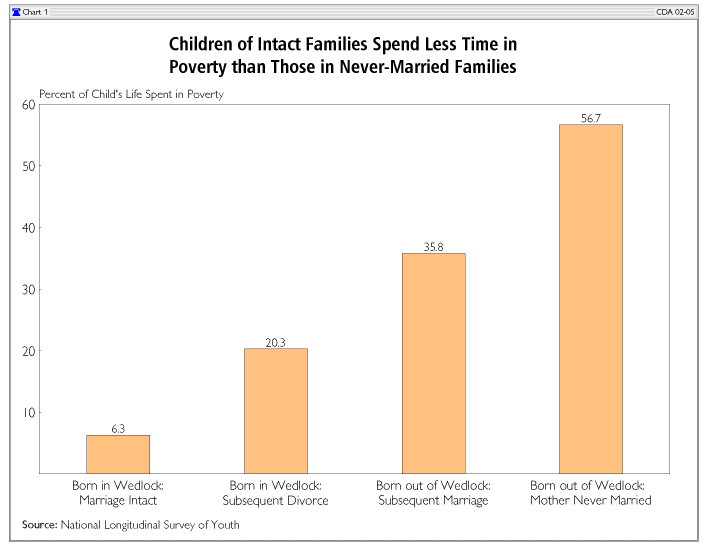
A second element of the analysis is separating the NLSY children by family structure. Using the birth, marriage, and divorce data in the NLSY, children were categorized into one of four groups:
- In-wedlock/intact marriage-children born inside marriage whose parents have remained together and never divorced.
- In-wedlock/subsequent divorce-children born to married parents who subsequently divorced.
- Out-of-wedlock/subsequent marriage-children born outside marriage whose mothers have subsequently married.
- Out-of-wedlock/never married-children born outside of marriage whose mothers have never married.
Finally, the NLSY provides data on the mothers' educational backgrounds. Mothers were grouped into one of three basic categories of educational attainment:
- High-school dropout.
- High-school graduate.
- With college degree.
Results
The results of the CDA analysis confirm the extremely strong effect of marriage in reducing child poverty. As Chart 1 shows, children born and raised in intact married families spend, on average, about 6.3 percent of their lives in poverty. Children in "never-married" families spend, on average, 56.7 percent of their lives in poverty. Put another way, children whose mothers never married are nine times more likely to be in poverty than those living in intact married families.
Long-Term Child Poverty
An examination of long-term child poverty reinforces the importance of marriage. Children may be defined as experiencing long-term poverty if they have spent half their lives or more in poverty.
On the basis of NLSY data, Chart 2 analyzes the relationship between family structure and long-term child poverty. As the chart shows, nearly 80 percent of all long-term child poverty occurs among children raised in never-married or broken families. (This group includes children of never-married mothers, children born outside marriage whose mothers subsequently married, and children born inside marriage whose parents subsequently divorced.)
By contrast, only 22 percent of long-term child poverty occurs among children born and raised in wedlock by both parents in an intact marriage. Long-term poverty is especially prevalent among the children raised by never-married mothers. Although children in never-married families comprise only 6.7 percent of all children in the NLSY, they account for 31.9 percent of all the long-term poor children.
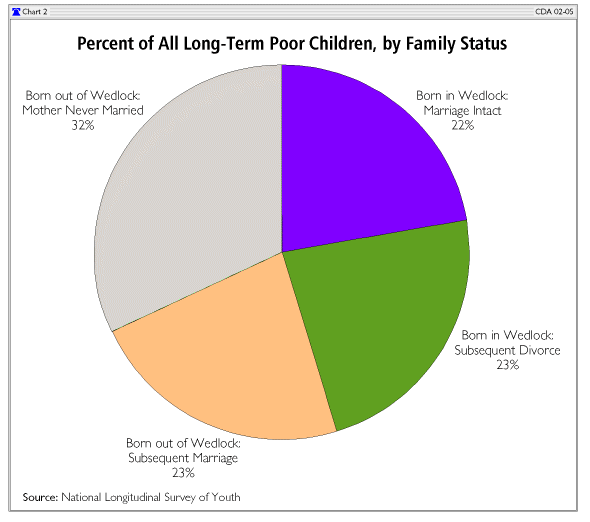
Comparative Effects of Marriage and Maternal Education on Poverty
While the effects of marriage in reducing child poverty appear enormous, it is true that, on average, mothers who give birth inside marriage have considerably higher education levels than do mothers who bear children out of wedlock. Therefore, some of the anti-poverty effects in Chart 1 may be due to the higher education level of married mothers rather than to marriage per se.
The data in Table 1 are helpful in disentangling the overlapping effects of marriage and education. As the table makes clear, both maternal education and family structure have an obvious effect on child poverty. Not surprisingly, the lowest child poverty rates occur among children raised in intact married families by college-educated mothers: On average, these children are poor 2.2 percent of their lives. By contrast, the highest child poverty rates occur among children raised by never-married mothers who are high-school dropouts: These children, on average, are poor 76 percent of their lives.
The data in Table 1 give no support to the contention that maternal education alone is important to reducing child poverty while marriage is unimportant. Not only does marriage, regardless of a mother's education, have a potent effect in reducing poverty, but the anti-poverty effects of marriage appear to be stronger than those of maternal education.
This finding is highlighted in Chart 3. As the chart shows, children whose mothers are never-married high-school graduates, on average, are poor 58 percent of their lives. If the never-married mother obtains a college degree, the child's poverty rate will fall to 28 percent. By contrast, the poverty rate of children raised in intact marriages by mothers who are high-school graduates is only 7.8 percent.

As the chart shows, a successful intact marriage has a far greater impact in reducing poverty than does adding four years of college to a mother's education. The poverty rate of never-married mothers with college degrees remains more than three times greater than the poverty rate of mothers with high-school degrees and intact marriages.
Even more telling, when the poverty rate of children in intact families whose mothers are high-school dropouts is compared to the poverty rate of children in never-married families with mothers who are college graduates, only a slight difference is found. Chart 4 shows that children raised in intact marriages by high-school dropouts spend 31 percent of their lives in poverty. On the other hand, children of never-married mothers who are college graduates, on average, spend a very similar 28 percent of their lives in poverty.
As Table 1 showed, children raised by never-married mothers have high levels of poverty regardless of maternal education. Similarly, children raised by mothers who are high-school dropouts have high levels of poverty regardless of family structure. The data suggest that an effective anti-poverty strategy should encourage women to finish high school and become married before having children. By contrast, an anti-poverty strategy that focuses exclusively on maternal education and is indifferent or hostile to marriage is unlikely to be successful.
Multivariate Analysis
In the next step of our analysis, we compare the effects of maternal schooling and family structure on poverty through two multivariate regression models.
Regression Model One
The first regression model is shown in Table 2. The dependent variable is the percent of a child's life spent in poverty. (This is the same measure used in Table 1.) The independent variables cover both education and family structure. Maternal education is measured by the number of years of schooling completed by the mother. Family structure is represented by four dummy variables:
- In-wedlock/intact marriage-children born inside marriage whose parents have remained together and never divorced.
- In-wedlock/subsequent divorce-children born inside marriage whose parents have subsequently divorced.
- Out-of-wedlock/subsequent marriage-children born outside marriage whose mothers have subsequently married.
- Out-of-wedlock/never married-children born outside of marriage whose mothers have never married.
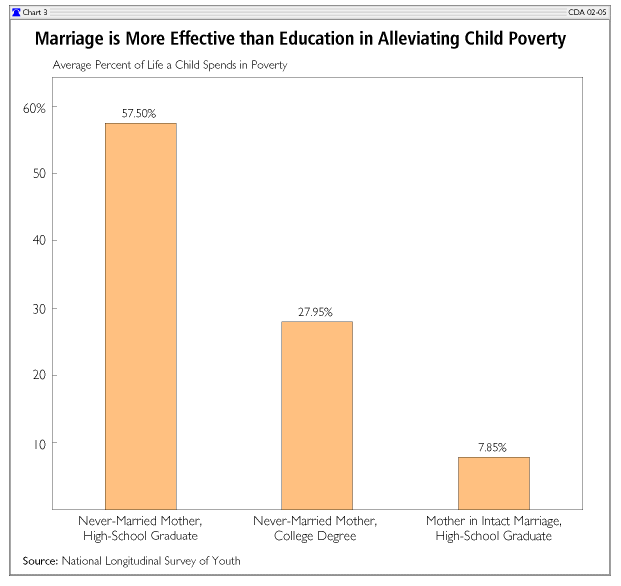
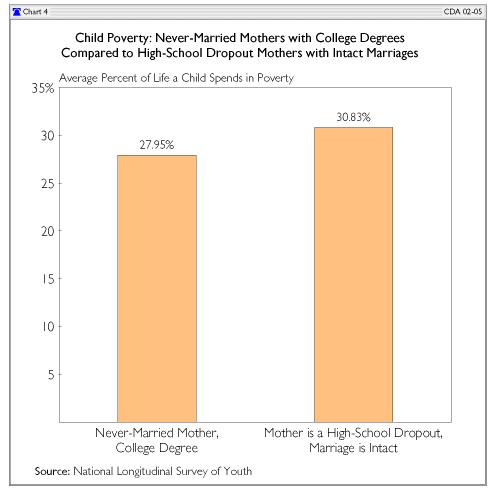
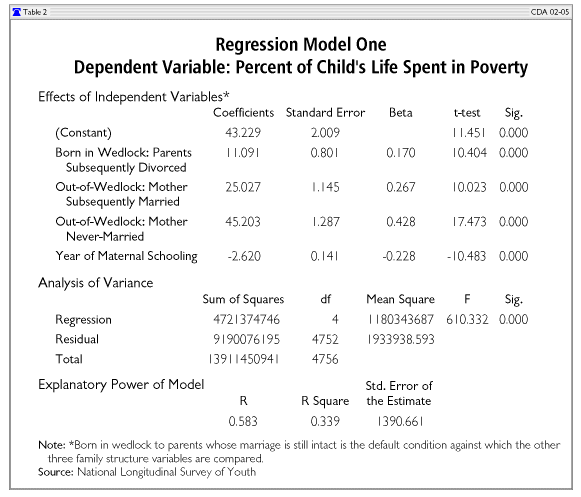
In the first regression shown in Table 2, in-wedlock/intact marriage is the default condition against which the other family structure variables are compared. Thus, the analysis shows that, holding maternal education constant, a child born in wedlock whose parents have subsequently divorced will spend, on average, 11.09 percentage points more time in poverty than will a child born and raised in an intact marriage.
The results again confirm that marriage is relatively more effective than education in alleviating child poverty. Holding maternal education constant, the typical child raised by a never-married mother spends 45.2 percentage points more time in poverty than the typical child born and raised in an intact married family. By contrast, maternal education reduces the duration of child poverty by 2.6 percentage points per year of schooling. Therefore, holding family structure constant, a child whose mother has four additional years of schooling (the difference between being a college graduate and being a high-school graduate) spends 10.5 percentage points less time in poverty (2.6 x 4).
Thus, this analysis indicates that a successful intact marriage is more than four times as potent in reducing child poverty as is a maternal college degree (45.2 percentage points compared to 10.5 percentage points).
Regression Model Two
A second weighted least squares regression model is presented in Table 3. The dependent variable is the same as in Table 2: the percent of a child's life spent in poverty. Maternal education is again measured by the number of years of school completed by the mother. In this model, however, the four family structure dummy variables have been replaced by a single continuous variable: the percent of a child's life spent in a single-parent home.
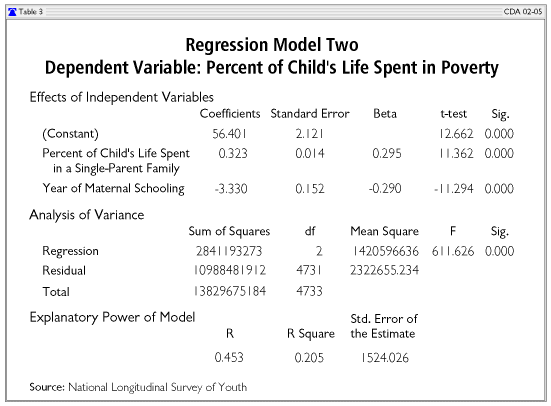
The results are similar to those shown in the regression in Table 2. Increasing the amount of time a child lives in a single-parent home by 10 percent will increase the likelihood of child poverty by 3.2 percentage points. Adding one year to a mother's education will reduce the likelihood of child poverty by 3.3 percentage points. According to this analysis, being raised continuously in a married two-parent family throughout childhood would have roughly twice as much effect in reducing poverty as adding five years to a mother's education.
The regression shows that both marriage and maternal education have a role in reducing child poverty. The more years a child lives in a married two-parent family, the less the probability of poverty; increasing a mother's education also reduces the probability of poverty. Overall, an extra year in a married two-parent family and an extra year of maternal education have roughly similar impacts in decreasing child poverty.
CONCLUSION
Reducing child poverty is an important public policy goal. This CDA Report builds on previous academic research that showed how child poverty would have been significantly lower if marriage among women of childbearing age had not declined over the past few decades. It also confirms other research that shows that 80 percent of poor single-parent families would escape from poverty if the single parents were married.
The current analysis indicates that, operating together, both marriage and maternal education can play a significant role in reducing child poverty. The most effective public policy to reduce child poverty would encourage young women both to complete high school and enter into a healthy marriage before they have children. By contrast, a policy that focuses on maternal education exclusively and is indifferent or hostile to marriage is not likely to be successful.
-Robert Rector is a Senior Research Fellow, and Kirk A. Johnson, Ph.D., is a Senior Policy Analyst in the Center for Data Analysis, at The Heritage Foundation.
APPENDIX
In order to evaluate the effects of marriage and education on child poverty, data from the National Longitudinal Survey of Youth (NLSY) were used. The NLSY is a nationally representative sample of young people who were between the ages of 14 and 22 at the end of 1978. Data on this cohort of individuals were collected annually from 1979 and 1994, and then biennially through 2000. The NLSY longitudinal sample provides detailed information on social and economic characteristics such as marriage, divorce, fertility, income, and poverty among Americans throughout the past three decades.
The NLSY has also collected data on children born to individuals in the original sample; these children represent a good cross-section of children born in the United States within the past three decades. Family income data in NLSY allow us to determine the number of years these children have lived in poverty.
The key outcome or dependent variable examined in this CDA Report is the "percentage of time in poverty," i.e., the percentage of a child's life spent in poverty. This is calculated by dividing the number of years a child has lived in poverty by the number of years the child has been alive. Thus, if a child is 10 years old and has lived in poverty for five years, "the time in poverty" would be 50 percent.
The first regression model, presented in Table 2, is a "jackknifed" weighted least squares regression. Percentage of time in poverty is the dependent variable. The three family-status variables for the children (in-wedlock/ subsequently divorced, out-of-wedlock/subsequently married, and out-of-wedlock/never married) are compared against the default condition of a child who was born in wedlock and raised in an always-intact family. The number of years of schooling of the mother is also included as an independent variable to enable the effects of marriage and education to be weighed independently.
The second regression model, shown in Table 3, is a "jackknifed" weighted least squares regression as well. The family status variables were replaced by an alternative variable: the percent of a child's life spent in a single-parent family. The number of years of schooling of the mother is again employed as the second independent variable. These results reveal that the impact on poverty of a 10 percentage point change in the time in a single-parent family (roughly 1.3 years in the average 13-year-old child) is roughly equivalent to the effect of an additional year of schooling for the mother.
A jackknifed weighted least squares regression is used to provide an accurate assessment of the statistical significance of the independent variables. A jackknifed procedure is necessary because of the complex sample design of the NLSY. The NLSY did not select the original survey members in 1979 on a purely random basis. Rather, the framers of the survey wanted a robust sample of low-income and minority respondents, so they "oversampled" these subpopulations relative to others. In order to make sure that their proportions in the total population remain constant, the entire sample must be re-weighted, based on information in the sampling weight.
The weighted least squares regression uses the child sampling weight of 1998 in the analysis. The jackknifed part of the regression model replicates that weight many times in order to calculate the t-test statistics associated with the model's regression coefficients. WesVar Complex Samples 3.0 software was used, specifying the BRR (balanced repeated replication) method to generate 120 sets of sampling weights (otherwise known as replicate weights). Information on the primary sampling units and sampling stratifications of the NLSY (provided in the original 1979 file) form the basis of the replicate weight generation.
If a researcher did a WLS model without running this jackknife procedure, the t-tests reported by the standard WLS would be higher than they should be because the weights inflate the t-tests. In short, the jackknife procedure deflates the t-test statistics, making it far less likely that a researcher would declare a variable as statistically significant. In this analysis, all of the independent variables in both jackknifed WLS models are statistically significant at the 1 percent level.


